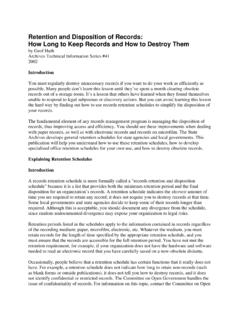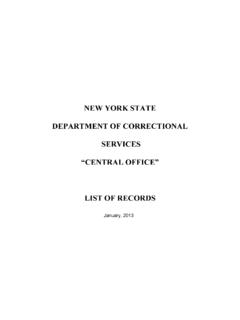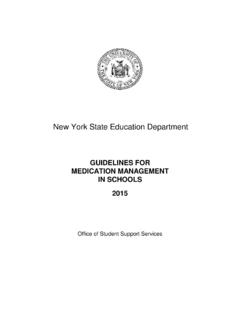Transcription of New York State Archives - Publication #FA07 - Guide to ...
1 Guide to Records of the department of correctional services New york State Archives Publication FA07. 1992. Contents 3 Development .. 4 Current 5 Description of Records .. 6 Content of Records .. 6 Format of Entries .. 7 General Administrative 8 Superintendent of State Prisons .. 8 department of 8 Bureau of Records and Statistical Analysis .. 8 Inmate Case 9 Division of Administration .. 9 Institutional Records .. 10 Albion correctional Facility .. 10. Attica correctional 14 Auburn correctional Facility .. 14 Bedford Hills correctional Facility .. 24 Clinton correctional Facility .. 27. Coxsackie correctional 34 Eastern New york correctional 35 Elmira correctional and Reception Center .. 37 Fishkill correctional Facility .. 41 Fulton correctional 46 Great Meadow correctional Facility.
2 46 Green Haven correctional Facility .. 47 New york House of 47 Sing Sing correctional 55 State Prison of the City of New york (Newgate) .. 57 Wallkill correctional Facility .. 59. Woodbourne correctional Facility .. 59 Records of the New york State Agricultural and Industrial 60 Administrative Records .. 61 Admission, Parole, and Discharge 62 Inmate Case and Behavior Records .. 63 Photographs and Printed 64 2. Introduction The records of the department of correctional services are among the most important materials available for research at the New york State Archives . From its beginning, New york State was a leader in innovative programs in penology. It established the first juvenile reformatory, the first reformatories for adult males and females, and the most influential early State prison for men.
3 These and other facilities established correctional practices that were replicated in numerous other states throughout the country. The records of New york correctional facilities comprise a unique resource for examining the development of these practices and the lives of tens of thousands of men and women confined in these facilities during the past two centuries. This Guide describes in detail records of the department of correctional services available for research at the New york State Archives . In addition, it lists records series from the New york State Agricultural and Industrial School, a juvenile reformatory opened in 1849 and currently operated by the Division for Youth. Most of the records were created at 16 correctional facilities representing the major types of correctional facilities in the State .
4 Nearly 4,000 cubic feet of records are described in the Guide . In addition to descriptions, the Guide includes unique histories that trace the development and current functions of each facility. More extensive descriptions of each of these record series are available at the State Archives . Use of a number of record series is restricted to protect the personal privacy of inmates confined in the State 's correctional facilities. Access to these restricted records may be permitted under certain conditions upon application to and approval by the State Archives . Records in the State Archives may be used at the Archives ' research room. For further information please contact Research Assistance. This Guide was prepared by Senior Archivist Richard Andress. 3. Development From the opening of the first State prison in 1797 until the present day, New york 's correctional system has had a wide influence on the direction of criminology and penology in the United states .
5 Among the important early institutions established in New york were Newgate Prison (1797), Auburn Prison (1818), New york House of Refuge (1824), Sing Sing Prison (1828), Clinton Prison (1845), Western House of Refuge (1849), Elmira Reformatory (1876), Western House of Refuge for Women (1893), and Bedford Hills Reformatory for Women (1901). Newgate, Auburn, Sing Sing, and Clinton were instrumental in the development of the nineteenth century penitentiary movement throughout the country. In particular, the "Auburn System" of discipline -- congregate work by day, solitary separation in cells at night, enforced silence, lockstep formations, and severe corporal punishment -- served as a model for similar institutions elsewhere. Elmira Reformatory was the first adult reformatory in the country and precipitated a national reformatory movement.
6 Elmira's innovative, highly publicized program included indefinite sentences based on conduct and performance, individualized treatment of inmates, and the extensive use of parole. In the development of reformatories for women, Bedford Hills was extremely important and its programs were emulated at many other institutions. Most influential were Bedford's programs for the scientific study of "feeblemindedness" and "defective-delinquency" as causes of crime. Until 1846, the State 's corrections system was administered by a board of inspectors that in turn appointed wardens for each prison. The 1846 State Constitution established a single Board of Prisons to oversee all State prisons; in 1876 this board was replaced by the Office of Superintendent of State Prisons. The reorganization of State government in 1925-1926 abolished the Office of Superintendent of State Prisons and created a department of Correction headed by a commissioner appointed by the governor (Laws of 1926, Chapter 606).
7 In addition to continuing the work of the Superintendent of State Prisons, the department of Correction also assumed the functions of the State Board of Charities relating to correctional institutions. Since 1867, the State Board of Charities and its predecessor, the Board of State Commissioners of Public Charities, had been responsible for supervising correctional institutions (except prisons). and reformatories in the State . The new department was comprised of four divisions: a Division of Administration responsible for custody of inmates and maintenance of institutions; a Division of Prison Industries supervising prison and reformatory production shops and farm work; a Division of Parole; and a Division of Probation. In 1930 (Chapter 824), the Division of Parole was transferred from the department of Correction to the Executive department .
8 In 1970 (Chapter 475), the present department of correctional services was created. It consolidated the previous department of Correction, the State Commission of Correction (established in 1926), and the Division of Parole. A 1970 companion law (Chapter 479) removed the Division of Probation from the new department and transferred it to the Executive department . In 1972 (Chapter 399), the department 's Division of Criminal Investigation was transferred to the newly formed Division of Criminal Justice services in the Executive department . In 1973 (Chapter 398), the Commission of Correction was also separated from the department and made an independent agency within the Executive department . In 1977, administration of hospitals for mentally ill inmates was transferred to the department of Mental 4.
9 Hygiene (Chapter 978) and the Division of Parole was again removed from the department and made an independent Executive department agency (Chapter 904). Current Functions The department of correctional services is mandated to operate safe and secure facilities in a humane and cost effective manner. Currently, the department is responsible for confining and habilitating approximately 52,000 inmates at more than 60 correctional facilities throughout the State . The department is responsible for confining these inmates at appropriate security levels, maintaining order through disciplinary action when necessary, and fulfilling the basic daily needs of inmates. In 1983, the department began an extensive expansion program to repair facilities and to open new facilities to meet the growing demand for additional inmate space largely resulting in the increase in drug related crimes.
10 Included were major renovations to existing facilities, construction of modular facilities, use of temporary facilities, and establishment of a number of new corrections camps including shock incarceration camps for drug offenders. To help meet the demand for new prison space and to help ease inmate adjustment after release, the department has also expanded inmate temporary release programs which include work and educational release, industrial training leave, and community services leave. Education offerings available at correctional facilities have also expanded greatly in the past decade. The department now offers a broad range of academic opportunities including high school equivalency programs, adult basic education, bilingual programs, and college credit programs. Volunteer programs have assisted in the expansion of academic programs and have focused on assistance in literacy, tutoring, pre- release preparation, and programs for inmates with special needs.

















